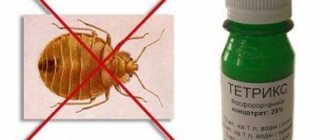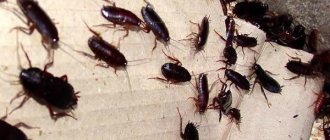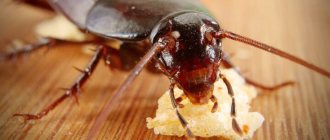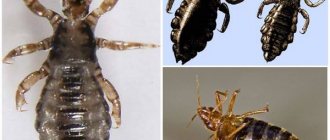What kind is this?
The white woodlouse is an arthropod that belongs to the suborder of crustaceans (read more about what type, class and order the woodlouse belongs to in this article). Has dimensions not exceeding 6 mm.
The presented species of crustaceans is characterized by the presence of an oval-shaped body, on top of which there is a slight bulge. The eyes are located on the side of the head. There are 6 pairs of abdominal legs. Body color is white or grayish (you can learn more about what woodlice look like and what types of this insect there are here).
Attention !
In their natural environment, woodlice can be found under fences, stones or stumps. Damp basements or sheds are considered favorite places. That is why woodlice takes root only in those houses where high levels of humidity prevail.
Pest definition
The white woodlouse is mistaken for an insect, but it is actually a crustacean. It is characterized as a terrarium nurse and can be used as food for exotic pets. The species is native to Central and South America , but has spread throughout the world.
Any decomposing plant debris is suitable for feeding the crustacean. The white woodlouse is exclusively nocturnal and is most active at this time. Find out what woodlice eat in the bathroom, apartment and other rooms here.
Information : in its natural environment, this species is found under stones, fences, and especially often under rotten stumps.
Read general information about woodlice here, we talked about other types of woodlice here, and the description, characteristics and classification of woodlice can be found in this material.
Photo
Next you can see what this woodlice looks like in the photo:
Reasons for appearing in the apartment
If you pay attention to the name of the species, you can understand that insects of this type prefer to live exclusively in damp areas . In such an environment, they feel very comfortable, especially if the room is cluttered, it is much easier for them to hide from others.
If we look at the last floors of multi-storey buildings, wood lice develop there due to the humidity in the attic, but apartments on the first floors suffer because of the basements.
If the general condition in the apartment is good, then, most likely, insects visit the apartment from neighbors through small cracks or ventilation.
We talked more about where woodlice come from, where they live and what are the reasons for their appearance in the apartment in a separate article.
How do they live and what do they eat?
Woodlice can get into the bathroom through the drain hole in the bathtub, through the ventilation shaft, and they travel through sewer pipes. Animals can get into the house through windows and doors. On upper floors they enter through the attic. They appear from cracks and cracks in ceilings, walls, and floor coverings.
Woodlice feed on organic debris. In the bathroom they eat:
- soggy paper;
- soap deposits;
- particles of dirt;
- plaque on tiles;
- microscopic fungi.
These creatures come out to look for food only in the dark.
Woodlice settle under the bathtub, behind baseboards or plastic panels, at the joints of seams. If there are leaks in the bathroom, moisture-loving creatures will definitely take a liking to the places behind the pipes. A wet mat in front of the bathtub or a cabinet with wet bath accessories is a paradise for wood lice. A high-risk area is a bathroom in a wooden house. A wood louse (another name for a wood louse) makes its way into the cracks of damp, rotting wood.
Having become comfortable in the bathroom, wood lice can move to other rooms in the apartment in search of food. Rooms with houseplants are more humid due to frequent watering, and organic flower debris is ideal food for woodlice. There is always something to eat in the kitchen, such as human leftovers.
What is the danger?
In general, woodlice poses virtually no danger to humans and their health; these insects do not bite and cannot spoil food, but their appearance is unpleasant to humans.
In addition to all this, insects carry viruses and fungi on their paws, and therefore are considered spreaders of many diseases .
In this regard, a person’s desire to get rid of such guests is quite natural.
Step-by-step instructions on how to get rid of it
If uninvited guests are still found in the toilet or bathroom, you should think about what method can be used to get rid of them most effectively. At this stage of time, you can use both folk remedies and chemicals.
Folk remedies
When getting rid of woodlice using folk remedies, you can follow these steps::
Make a concentrated aerosol containing pepper, salt and tobacco. In order to do everything correctly, you need to take about one teaspoon of each of the components, mix thoroughly and infuse in a liter of water. It should be sprayed in the area where woodlice spread most actively, since this is where their home is located.- If the house is old and the walls constantly become damp, it is necessary to pour a handful of salt in the corners, which will absorb moisture and thereby create uncomfortable living conditions for wood lice.
- Boric acid is also considered an excellent remedy. The presented product should simply be scattered in places where insects accumulate.
Chemicals
In addition, you can use chemicals, of which there are a lot on store shelves these days:
The most common and popular remedies currently considered are Dichlorvos and Tarax . These products have the ability to additionally rid the room of other types of annoying insects. As for the white woodlice, the poison acts on it precisely by contact, that is, having sprinkled the insect, the poison destroys the surface of the hard shell, and thus the insect dies, while infecting its fellows.
The next most popular remedy is Varan . Dichlorvos Varan is a drug from the group of synthetic insecticides. It is produced mainly in aerosol form. It is sprayed onto the walls, ceiling and floor of the room. Thus, the insect will be poisoned and die. It works for up to twenty days, and insects do not get used to it.- In addition to the above remedies, there are other types of aerosols that are widely used, but they must be sprayed and left the room for several hours.
In the event that white woodlice entered the room through a drain, then the ideal remedy here would be a Mole for cleaning pipes. Mole is a tool for clearing clogged pipes, created back in the mid-twentieth century. This remedy is very effective and useful if insects have settled in your pipes or are visiting your home through them. Thus, you can get a double effect - kill insects and clean the pipes.
Woodlice are not visible during the day; they crawl out in search of food at nightfall. What they eat in our homes and what types there are, you will learn from separate articles on our Internet portal.
Woodlice in the bathroom - fighting techniques
Many are faced with a situation where, instead of relaxing in a bathtub with warm water, they feel disgust and reluctance to enter this room, because terrible and vile creatures called woodlice live there.
In addition to the well-known pests in the apartment - cockroaches, other small insects, for example, ants, also settle there. A common picture is that ants move one after another along the walls or floor of the bathroom, often entering rooms through cracks in the walls.
Learn more How to get rid of pubic lice
Woodlice are one of the most popular bathroom insects and have much less pleasant characteristics than ants. They move around the bathroom quite quickly and it is very difficult to get rid of their presence.
These crustaceans do not cause significant harm to humans, except that they are often carriers of fungus and lichen. How to rid your bathroom of woodlice?
- First of all, care should be taken to maintain cleanliness. When performing wet cleaning, be sure to wipe down the walls with an effective liquid detergent such as Domestos.
- Reduce room humidity. To do this, keep the bathroom door open and dry any spills on the floor or walls of the bathtub after use. Make sure there is no dampness and ventilate the room as often as possible.
- A special grille equipped with a mesh on the inside must be installed on the outlet ventilation pipe.
Important: when installing, make sure there are no gaps.
- In addition, it is necessary to maintain the correct climate; it is recommended to purchase devices such as a heated towel rail and a bathroom hood.
- It is recommended to install a fan or heater that produces dry, moist air.
- Check the hoses for leaks and malfunctions, since the slightest leak creates favorable conditions for the development and reproduction of insects.
An effective remedy: mix a small amount of red pepper with a small amount of soda ash and tobacco. Dissolve the resulting mixture in a liter of water. Spray the corners of the bathroom with this solution. After 7-8 hours, the bath is treated using chlorinated water.
To combat woodlice, special baits can be used.
It often happens that the above methods do not help get rid of woodlice in the bathroom. If you tried different methods, but none helped, invite specialists.
Prevention
It is better to prevent the appearance of insects such as white wood lice than to deal with them gruelingly later. Due to the fact that woodlice can breathe through gills, it really needs water. Thus, if the humidity in the room becomes moderate, then uninvited guests will leave or will not appear at all.
In order to achieve this, it is enough to install additional ventilation in a damp room for more intense air exchange, this will help get rid of not only woodlice, but also unnecessary dampness. During the winter season, you can put a heater in the bathroom for a while to dry the room.
You should not leave dirty dishes in the sink all night, as woodlice “come out” at night and search for food throughout the house. Thus, adhering to simple rules, if you create an optimal habitat and microclimate in the room, wood lice will not appear , since it will be very uncomfortable for it to live in conditions where there is no high level of humidity.
If you find an error, please select a piece of text and press Ctrl+Enter.
Types of woodlice that can live in a house or apartment
Do you think that woodlice is an unusual insect? In reality, we are looking at creatures that belong to the genus Crustaceans. If there are 3 pairs of “legs” on the insect’s body, then woodlice can boast of a huge number of them. The legs are very mobile, allowing them to move on different surfaces and climb vertical walls. Woodlice also have real gills.
Woodlice are a rare occurrence in residential areas. They give preference to moist, warm buildings where there is enough food. But what kind of “living creatures” are they and can they harm humans? What species live in Russia and how to distinguish them from insects?
Scientists have found that there are about 3,500 species of these crustaceans in the world, but in Russia only a dozen of them can be observed. The fact is that we have only the most adapted types of crustaceans that can survive at low temperatures and moderate humidity.
Most often, a person encounters 2 types of woodlice - common (armadillo) and rough . They enter houses from very humid places and can survive even in an apartment. But crustaceans feel much better outside. They feed exclusively on plant foods, fruits, grass, vegetables, and can absorb already decomposed organic matter. Woodlice are found in gardens, homesteads, and front gardens. They hide in dark places, under flat stones, preferring heavily moist areas.
But what type of woodlice can we “encounter” in the bathroom or toilet of our apartment?
Woodlouse armadillo
Before us is the most typical species of crustacean that lives in Russia. Armadillidium vulgare (common woodlice), it is called the armadillo because of the characteristic covering of the body of the woodlice. It resembles a dense dark shell that rises above the body.
True, they are not found so often in apartments. But they reproduce well in damp cellars, damp basements, and heating pipes. But in gardens, parks, on roadsides, and flower beds it’s easier to see them. They hide under stones or flat objects that lie tightly to the ground.
It is easy to recognize a woodlouse - it moves very slowly, and when in danger, it immediately curls up into a ball, completely protecting its soft body with a shell.
Since woodlice consume plant food, they can cause significant damage to flowers and crops. But as practice shows, more often the common woodlice prefers plants that people do not cultivate (weeds).
Woodlouse rough
This type of crustacean is called Porcellio scaber . Unlike ordinary pests, it prefers residential wet areas. Woodlice has a softer shell, its legs are mobile, so they move quickly. Able to overcome obstacles in the form of vertical walls of houses and entrances. They readily migrate from a damp basement or roof directly into a person’s home.
Rough woodlice (cellar woodlice) have an interesting feature. Depending on the area where they live, the appearance of woodlice varies greatly.
The pigmentation of the integument varies:
- Lives in the southern region - the shell is gray, there is a pink tint.
- Northern regions - yellow or reddish color.
- The eastern regions of the country have a dark shell, sometimes completely black.
If you catch a rough woodlice, it will not curl up into a ball, but will begin to actively arch and move all pairs of legs.
If ordinary woodlice, penetrating into our home, only cause disgust, then Porcellio scaber (rough ones) can cause serious harm. Crustaceans are very active, capable of covering long distances in a short time, eating house plants along the way.
They are no less dangerous for greenhouses, greenhouses, vegetable gardens and orchards. If they get into the cellar, they will feed on your supplies; in warehouses they destroy stored agricultural products. True, if you notice them in the bathroom or toilet, there is no reason to be afraid. They cannot bite you or harm finishing materials, but they must “hint” that there is a very damp place nearby from which they enter your home.
Woodlouse Cylisticus convexus
- This type of crustacean rarely lives in apartments and private houses. They prefer agricultural land. For example, barns, cowsheds, and other buildings where vegetables, hay, and organic products are stored;
- woodlice do not pose a danger to humans. You can recognize them by their very long churches. These are protrusions on the abdomen of woodlice that closely resemble antennae.
Trachelipus rathkei
- But this type of woodlice does not even “deserve” the name in Russian, although they live in numerous cities of Russia (middle zone). Feature – adapt to any living conditions;
- crustaceans have a flattened, wide shell (towards the bottom of the body), they have long antennae;
- Woodlice live in almost all regions of the planet, prevailing in Russia, the USA, Europe, and Canada.
Porcellio spinicornis
- These woodlice have a unique coloring - there are two rows of bright yellow dots on their shell. “Marks” may be more expressive or dull depending on the type of woodlice. The antennae of these crustaceans are also different - they have 3 segments, are strongly curved, and on each segment the antennae bends at different angles;
- peculiarity - it has been noticed that crustaceans prefer to grow near limestone deposits, while they feel great in rooms made of foam concrete. Lime-whitened walls also attract crustaceans.
“Domestic” species of woodlice – which representatives live in the world?
It is worth noting that in some regions of our planet woodlice settle in houses and apartments more often. Moreover, other varieties that are atypical for Russia adapt to residential premises.
For example, in the Mediterranean countries and Europe the “rating” of “domestic” crustaceans looks like this:
- The palm (prevalence) is held by the armadillo woodlouse.
- The second place was taken by the desert woodlouse of Reaumur. It is considered a crustacean, but it leads a land-based lifestyle. This woodlice lives even in deserts and very dry regions, which is completely uncharacteristic for organisms.
But residents of tropical countries suffer from woodlice that settle in their houses much more often. They are not much different from the crustaceans that predominate in Russia.
Woodlice or just similar?
Despite the fact that these crustaceans have a specific appearance that distinguishes them from insects, many people confuse them with other pests. Sometimes apartment owners mistake silverfish for woodlice. Although the difference in appearance is obvious. The silverfish has a characteristic body shape, which sharply tapers towards the end. The segments are not so pronounced, the antennae are not long.
This kind of silverfish can most often be found in damp rooms
In the south of Russia, another creature lives in cellars, “masquerading” as woodlice. They are called kivsyak, the most common type is Crimean kivsyak .
It is not difficult to confuse woodlice with centipedes, which also have an elongated body and many legs that move quickly.
If wood lice of any kind appear in your home, be sure to find out where they are entering the room from. Take all measures to get rid of excess moisture that woodlice like. This way you can prevent the invasion of these crustaceans.











